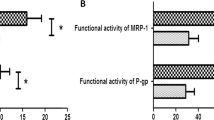Abstract
The response to cyclophosphamide (CP) is variable and difficult to predict in children with idiopathic nephrotic syndrome (INS). The polymorphic expression of glutathione-S-transferase (GST) may affect the remission rate after CP therapy. In this study, we evaluated the correlation of GST polymorphism and response to CP in INS. We studied GST polymorphism in 74 children with steroid-sensitive (44) and steroid-resistant (30) INS receiving intravenous cyclophosphamide (IVCP) therapy. We correlated GSTM1, GSTT1, and GSTP1 genotypes with response to IVCP. Thirty-seven (50%) out of 74 children responded to CP therapy. A synergistic effect of three genotypic combinations showed significant correlation with remission in the steroid-sensitive group. These combinations were GSTP1 and GSTM1 null genotype (p = 0.013) and GSTP1 together with GSTM1 and GSTT1 null genotypes (p = 0.026). Further, a significant difference was observed with a combination of GSTM1 and GSTT1 null genotypes and Val105 polymorphism. No association was observed among steroid-resistant patients. Our results indicate that among children with steroid-sensitive NS, there is an association with response to IVCP therapy and combination of GSTP1 Val105 polymorphism and the null genotypes of GSTT1 and GSTM1. GST polymorphism may be of significance in the management of children with INS receiving CP therapy.
Similar content being viewed by others
References
Nash MA, Edelmannn CM Jr, Bernstein J, Barnett JL (1992) The nephrotic syndrome. In: Edelmann CM Jr (ed) Paediatric kidney disease, 2nd edn. Little Brown and Co., Boston, pp 1247–1265
Gulati S, Kher V, Elhence R, Kumar P, Sharma RK, Gupta A (1994) Treatment of nephrotic syndrome. Indian Pediatr 31:165–170
Gulati S, Pokhariyal S, Sharma RK, Elhence R, Kher V, Pandey C, Gupta A (2001) Pulse cyclophosphamide therapy in frequently relapsing nephrotic syndrome. Nephrol Dial Transplant 16:2013–2017
Vester U, Kranz B, Zimmermann S, Hoyer PF (2003) Cyclophosphamide in steroid sensitive nephrotic syndrome: outcome and outlook. Pediatr Nephrol 18:661–664
Jones BF (1993) Cyclophosphamide pulse therapy in frequently relapsing nephrotic syndrome. Nephron 63:472
Valeri A, Radhakrishnan J, Estes D, D’Agati V, Kopelman R, Pernis A, Flis R, Pirani C, Appel GB (1994) Intravenous pulse cyclophosphamide treatment of lupus nephritis: a prospective five-year study. Clin Nephrol 42:71–78
Elhence R, Gulati S, Kher V, Gupta A, Sharma RK (1994) Intravenous pulse cyclophosphamide –a new regime for steroid resistant minimal change nephrotic syndrome. Pediatr Nephrol 8:1–3
Latta K, von Schnakenburg C, Ehrich JH (2001) A meta-analysis of cytotoxic treatment in frequently relapsing nephrotic syndrome in children. Pediatr Nephrol 16:271–282
Busse D, Busch FW, Bohnensrengel F, Eichelbaum M, Fischer P, Schumacher K, Kroemer HK (1997) Dose escalation of cyclophosphamide in patients with breast cancer: consequences for pharmacokinetics and metabolism. J Clin Oncol 15:1885–1896
Hengstler JG, Arand M, Herrero ME, Oesch F (1998) Polymorphisms of N-acetyltransferases, glutathione S-transferases, microsomal epoxide hydrolase, and sulfotransferases: influence on cancer susceptibility. Recent Results Cancer Res 154:47–49
Hayes JD, Pulford DJ (1995) The glutathione S-transferase supergene family: regulation of GST and the contribution of the isoenzymes to cancer chemoprotection and drug resistance. Crit Rev Biochem Mol Biol 30:445–600
Mannervik B, Awasthi YC, Board PG, Hayes JD, Di Ilio C, Ketterer B, Lisowsky I, Morgenstern R, Muramatsu M, Pearson WR, Pickett CB, Sato K, Widersten M, Wolf CR (1992) Nomenclature for human glutathione transferases. Biochem J 282:305–306
Stanulla M, Schrappe M, Muller Brechlin A, Zimermann M, Welte K (2000) Polymorphisms within glutathione s-transferase genes and risk of relapse in childhood B-cell precursor acute lymphoblastic leukemia: a case control study. Blood 95:1222–1228
Driven HA, van Ommen B, Van Bladeren P (1994) Involvement of human glutathione S-Transferase isoenzymes in the conjugation of cyclophosphamide metabolites with glutathione. Cancer Res 54:6215–6220
Seidegard J, Vorachek WR, Pero RW, Pearson WR (1988) Hereditary differences in the expression of the human glutathione transferase active on trans-stilbene oxide are due to a gene deletion. Proc Natl Acad Sci USA 85:7293–7297
Strange RC, Fryer AA (1999) The glutathione S-transferases: influence of polymorphism on cancer susceptibility. IARC Sci Publ (148):231–249
Harries LW, Stubbins MJ, Forman D, Howard GC, Wolf CR (1997) Identification of genetic polymorphisms at the glutathione S-transferase Pi locus and association with susceptibility to bladder, testicular and prostate cancer. Carcinogenesis 18:641–644
Vester U, Kranz B, Zimmermann S, Hoyer PF (2005) The response to cyclophosphamide is influenced by polymorphic expression of glutathione-s-transferases M1 and P1. Pediatr Nephrol 20:478–481
Brodehl J (1996) Management of nephrotic syndrome in children. Clin Immunother 5:175–192
Iyer L, Ratain MJ (1998) Pharmacogenetics and cancer chemotherapy. Eur J Cancer 34:1493–1495
Yuan Z-M, Smith PB, Brundrett RB, Colvin M, Fenselau C (1991) Glutathione conjugation with phosphoramide mustard and cyclophosphamide. Drug Metab Dispos 19:625–628
Acknowledgements
We are indebted to the Department of Biotechnology, Government of India, New Delhi, for the financial assistance for conducting this study.
Author information
Authors and Affiliations
Corresponding author
Rights and permissions
About this article
Cite this article
Sharda, S.V., Gulati, S., Tripathi, G. et al. Do glutathione-S-transferase polymorphisms influence response to intravenous cyclophosphamide therapy in idiopathic nephrotic syndrome?. Pediatr Nephrol 23, 2001–2006 (2008). https://doi.org/10.1007/s00467-008-0883-1
Received:
Revised:
Accepted:
Published:
Issue Date:
DOI: https://doi.org/10.1007/s00467-008-0883-1




